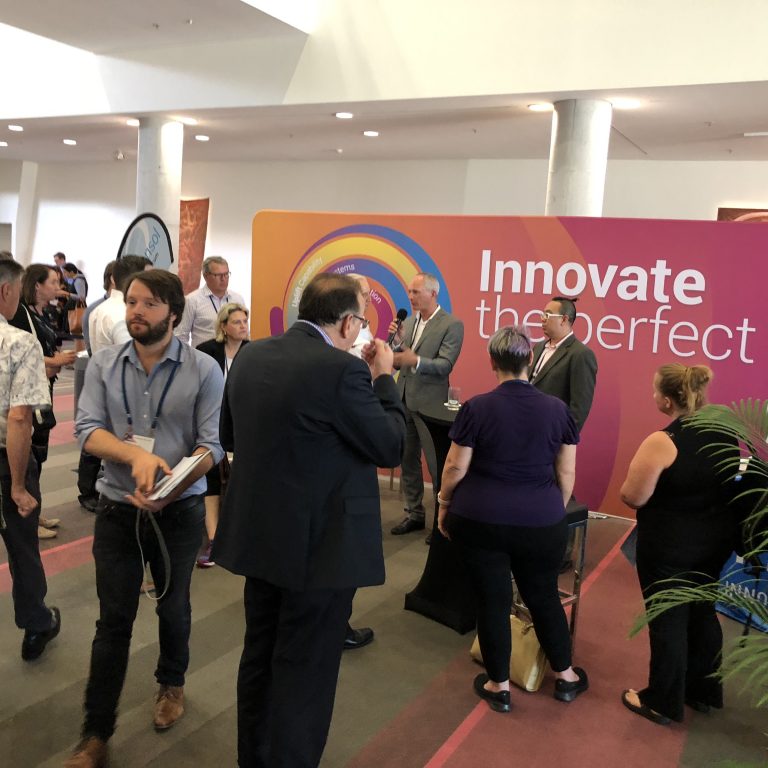Technology is continuing to change the world at such advanced rates that business-as-usual is no longer good enough[1]. To thrive in the business world, organisations must be able to continuously innovate[2] [3]. Research suggests that innovation-active organisations are competitively positioned to respond to external changes; generate higher profits; and have more employment and training opportunities[4] [5].
In 2011 Strategy+Business found that a culture which actively supports innovation was far more critical to driving positive innovation results than simply spending on Research and Development[6]. This supports more recent studies that suggest organisations fail in their innovation projects because they overlook internal business operations – continuing with traditional systems, governance and rewards mechanisms[7] while investing solely in innovation processes[8].
Equipped with this knowledge, organisations are keen to establish a culture of innovation, and commit to this as a key strategic initiative[9]. Recognising that growth should come from within, businesses are engaging in large-scale culture-change projects to improve their ability to innovate and respond to market shifts and opportunities[10].
However, these complex transformation projects often fail due to several barriers including: a lack of leadership and direction; poor or overly ambitious project scoping; as well as siloed mind sets and risk aversion.
A widely recognised barrier to culture-change projects is a lack of management support; executive support and leadership are critical to a project’s selection, implementation and success. The lack of clear direction and managerial support has been identified as the number one reason why change programs fail, particularly when leaders fail to communicate a compelling case for change.[11]
Projects that are too broad or ambitious in scope will often result in failure. Organisations that attempt to change all their internal operations at once, risk negatively affecting the organisation[12]. Senior leaders are often responsible for defining and approving project scope and this can lead to a knock-on effect between a lack of leadership and poor project scoping.
Research completed in 2016 found that risk aversion, as well as siloed mind-sets and behaviour were critical areas that required intervention if an organisation hoped to establish a culture of innovation. The research found that these cultural obstacles reflected negative economic performance, thus presenting a significant barrier to digital effectiveness[13]. In a WIRED article, Edward Goldman identified an organisation’s aptitude to risk as a key factor influencing organisational change. He recognised that organisations who were risk averse would continue to reward and invest in projects where success was assured, as opposed to supporting failure as part of the innovation process[14].
To change mind-set and behaviours, substantial research in change management has recognised the importance of obtaining employee engagement and supporting staff behavioural change. This can be achieved through a variety of practices including: communicating a compelling case for change; reinforcing behaviours through systems and processes; investing in internal expertise; and as highlighted earlier, by securing senior executive approval and support[15].
As technology continues to advance, tools can support this process of engagement: more frequent and personalised communication can be implemented to deliver relevant updates to engage and reassure colleagues; digital platforms and online training providers offer creative and time-considerate opportunities for developing skills and talent; and social networks foster collaborative cultures within the organisation[16].
For example, CSAA Insurance Group (CSAA IG) wanted to create a pervasive culture of innovation, and recognised that to do so, they needed to do more than simply support individual innovation projects. They set upon a culture change journey that engaged their employees. To support this commitment, they completed a range of initiatives including: publishing a strategic plan which communicated an organisational emphasis on innovation; developing core competencies to assess and develop employees; delivering innovation training to all employees to improve skillsets; and generating engagement with an idea management platform by visibly rewarding those who chose to participate[17].
This evidence suggests that traditional approaches to developing a culture of innovation are not sustainable as they do not address key inhibitors such as operational systems and processes that cannot support continuous change. To establish a culture of innovation, organisations need to: secure executive approval and leadership; engage their employees; and optimise and align their internal business operations by exploring technological advancements.
At Procensol we’ve been developing a comprehensive Framework to guide organisations through big change and innovation and leadership and culture are two of the major tenets of the Framework we’re building. You can read more about it below.
How the MBT Framework can assist in creating a culture of innovation:
The Modern Business Transformation (MBT) Framework offers a comprehensive approach to address the twin challenges of being able to innovate continuously, while also being agile enough to ensure internal operations can keep pace with the change. The Framework achieves this by embedding innovation through operational agility and focusing on innovation execution and change preparedness.
The Transformation Strategy, established early in the adoption of the MBT Framework, outlines an organisation’s transformation program to improve their ability to innovate and support change. The strategy includes tangible recommendations that require engagement, review and approval by senior leadership, thus securing executive approval.
As a high-level strategic document, the Transformation Strategy communicates a compelling case for change, in consideration of organisational context and background, this helps to engage employees in the transformation journey by explaining why the change is necessary.
The Transformation Strategy supports the entire transformation program by enabling the three pillars of the MBT Framework: Uplift Capability, Enhance Systems and Embed Innovation.
- Uplift Capability: identifies and addresses aspects of business operations that must be optimised to support innovative change. This process prioritises specific areas for optimisation to ensure they do not act as an inhibitor to innovation while ensuring progress is practical and achievable. This pillar will also review internal mechanisms to ensure they are innovation-centric.
- Enhance Systems: implements an agile and strategic approach to technology architecture and migration so that internal systems can keep pace with the business and market changes. This equips the organisation with the tools to proactively engage with emerging opportunities.
- Embed Innovation: establishes practices for continuous innovation so that ideas either ‘fail fast’ or ‘operationalise quickly’. This process generates excitement and engagement with innovation processes and embeds skills and knowledge of innovation across the business, helping an organisation to become less risk-averse and more comfortable with the concept of failure.
At its core, the MBT Framework adopts a sustainable approach to embed innovation as part of the organisation’s DNA. This successfully fosters a culture of innovation that transforms an organisation’s internal operations so that they are positioned to quickly capitalise on market opportunities and operationalise innovative ideas at speed.
Learn more about the MBT Framework here.
References
[1] Leonhard, G. (2016) Digital Transformation: are you ready for exponential change? https://www.youtube.com/watch?v=ystdF6jN7hc
[2] Lafley, A.G. Charan, R. (2008) Why Innovation Matters – https://www.fastcompany.com/874798/why-innovation-matters
[3] Palangkaraya, A., Spurling, T., & Webster, E. (2015). Does Innovation make SME firms more productive. Reserve Bank of Australia conference, 18-20 March, (p. 16). Sydney.
[4]Australian Industry Group (2016) Joining Forces: Innovative success through partnerships http://cdn.aigroup.com.au/Reports/2016/JoiningForces_Innovation_success_through_partnerships_Sept_2016.pdf
[5]Office of Chief Economist (2016) Australian Innovation System Report – https://industry.gov.au/Office-of-the-Chief-Economist/Publications/Documents/Australian-Innovation-System/2016-AIS-Report.pdf
[6] Strategy+Business (2011) Why Culture is Key https://www.strategyand.pwc.com/media/file/Strategyand-Global-Innovation-1000-2011-Culture-Key.pdf
[7] Goldman, E (2013) Creating a culture of innovation – https://www.wired.com/insights/2013/10/creating-a-culture-of-innovation/
[8] Kaplan, S. (2017) How one insurance firm learned to create a culture of innovation https://hbr.org/2017/08/how-one-insurance-firm-learned-to-create-an-innovation-culture
[9] Wunker, S. (2015) 5 Strategies big businesses use to build a culture of innovation – https://www.forbes.com/sites/stephenwunker/2015/07/29/5-strategic-big-businesses-use-to-build-a-culture-of-innovation/#40030115740e
[10]Basford, T. Schaninger, B. (2016) The four building blocks of change – http://www.mckinsey.com/business-functions/organization/our-insights/the-four-building-blocks–of-change
[11] Juran Global (2014) The No1 reason why performance improvement programs fails – a white paper by Juran Global – http://info.juran.com/hubfs/documents/9002%20The%20No.%201%20Reason%20Why%20Performance%20Improvement%20Programs%20Fail.pdf
[12] Juran Global (2014) The No1 reason why performance improvement programs fails – a white paper by Juran Global – http://info.juran.com/hubfs/documents/9002%20The%20No.%201%20Reason%20Why%20Performance%20Improvement%20Programs%20Fail.pdf
[13] Goran, J. LaBerge, L. Srinivasan, R. (2017) Culture for a digital age – http://www.mckinsey.com/business-functions/digital-mckinsey/our-insights/culture-for-a-digital-age
[14] Goldman, E (2013) Creating a culture of innovation – https://www.wired.com/insights/2013/10/creating-a-culture-of-innovation/
[15] Basford, T. Schaninger, B. (2016) The four building blocks of change – http://www.mckinsey.com/business-functions/organization/our-insights/the-four-building-blocks–of-change
[16] Basford, T. Schaninger, B. (2016) Winning hearts and minds in the 21st century –http://www.mckinsey.com/business-functions/organization/our-insights/winning-hearts-and-minds-in-the-21st-century
[17] Kaplan, S. (2017) How one insurance firm learned to create a culture of innovation https://hbr.org/2017/08/how-one-insurance-firm-learned-to-create-an-innovation-culture
About the Author
Chris O'Connor
Independent Consultant
MBT Independent Consultant, Chris O’Connor is focused on helping organisations to find the right mix of innovative practices, operational agility and organisational maturity. Chris has over 25 years of experience working with small and large organisations in a variety of industries and experiencing the common problems that the need for change brings. His experience includes organisational transformation, culture and performance, operational change program, innovation and agility, technology lead change initiatives and business and technology integration.
Related Posts

Innovation-as-Usual
“Nobody gets excited if you elaborate on what’s broken…” Professor Michael Rosemann joins us on the Procensol and MBT booth at BiiG 2017 to discuss…
Read More
The essential ingredients for lasting innovation
Three innovation themes appearing in digital strategy and innovation events throughout Brisbane and Sydney...culture, collaboration and frameworks...
Read More

